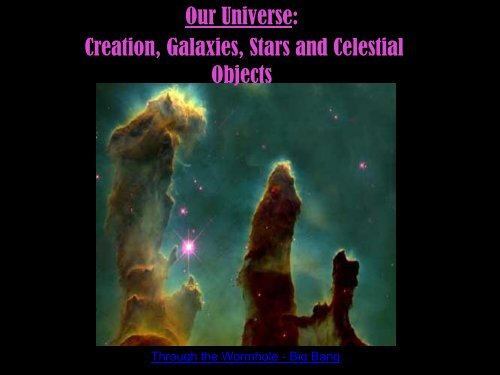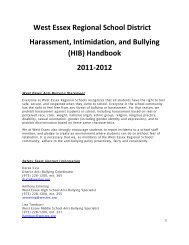Astronomy PPT
Astronomy PPT
Astronomy PPT
- No tags were found...
You also want an ePaper? Increase the reach of your titles
YUMPU automatically turns print PDFs into web optimized ePapers that Google loves.
Open Universe•This theory states thateverything in the universewill continue to moveoutward and away withcontinual expansioninfinitely.•Eventually, all starswould burn out leavingour universe with emptydarkness.Future of the UniverseClosed Universe•This theory supports theidea that eventually thatoutward expansion from theinitial Big Bang will wear.•At this point, the force ofgravity will begin to pulleverything back togetheragain.•Then, another Big Bangwill occur!Flat UniverseA flat universe resultsif the expansion slowsto a halt in an infiniteamount of time butnever contracts.Expansion occurs soslow that it appears tohave stopped.
3 Types of GalaxiesGalaxy- a cluster of billions and trillions of stars boundtogether by gravityElliptical Galaxyroundand flattenedovals(This is the mostcommon type of galaxy)Irregular Galaxysmallergalaxies withno distinct shape.Spiral Galaxy-Galaxies with spiralingarms that rotatearound a central bulgeof massive substancein the center.
Our Galaxy:The Milky Way•Our Milky Way is a spiral galaxy.•The center of our galaxy is full ofextremely massive, Red Super-Giant Stars.•The center is over 28,000 lightyears away. Which means it takes28,000 years for the light of thestars in the center to travelthrough space and be seen by ourplanet!!!•The direction towards the centeris toward the constellationSagittarius•1 light year (which is measure ofdistance NOT time) is the distancelight travels in a year. Light travelsat a speed of 9.5x10 15 m/s!!!•Our galaxy contains over 200billion stars!Sun orbitalspeed aroundthe center is220km/s, orbitalperiod is 240million years.The sun willcomplete 20revolutionsaroundcenter in itslifetime.SunIt is believed that there may be a massiveblack hole at the center of our galaxypulling the massive supergiants in!!How small a part of the Universe are we?1 light year = 5,865,696,000,000 miles!!!
Life Cycle of a StarWhite dwarf willeventually stopnuclear fusionand become ablack dwarf-”Dead Star”MediumStarGravity condenses thestar to shrink(Where protostars areformed)Giant StarStar Size Comparison
Nebula- the birth of a starOrion NebulaHorsehead NebulaLagoon NebulaA Nebula is a cloud of cosmic gas anddust where stars are formed.•The gases of these nebulas are mostlyhydrogen and helium.• These are the two gases that makeup all stars!•Gravity begins to pull the gases inwardduring the birth of a star (accreation).•Then, with gravity, the density of thegases increases which causes thepressure and temperature to increase,until the star finally stabilizes.•A star can exist anywhere from 1Million to 30 Billion years! (dependingon size)•Our Sun has around 5 Billion yearsremaining. It is predicted to only existfor 10 Billion total years.
Protostar:•A baby star•These are formed in the nebulas after the gaseshave condensed enough to begin nuclear fusion.•Nuclear Fusion is the process that occurs in thecores of all stars.•In Nuclear fusion, hydrogen atoms areconverted into helium, releasing the ENORMOUSamount of energy that causes stars to become sovery hot! The amount of energy released pergram of mass is equal to the amount ofenergy released by 22,000tons of TNT. (The nuclearexplosion at Hiroshima onlyreleased an amount equalto 13,000 tons of TNT)Young StarsMedium Star:• Temperature= 6000°C• Color = yellow/orange• Example= Our Sun (closest star isproxima centauri)• Size= over 90 million miles indiameter! (actually measured in solarradii)
Giant and Supergiant StarsGiant Stars•Color= Red or orange•Temperature= 4500°C•Size= 10 x the size of the SunRed Super Giant Stars•Color= Red•Temperature= 3000°C•Size= 1000 x the size of the Sun!!As size increases, the temperature decreases because the heat of nuclearfusion is spread out over such an enormous volume!
Supernova (largemass) or PlanetaryNebula (small mass)•If a star is extremely massive, theextreme density of the corecollapses under the gravitycausing a stellar explosion knownas a supernova.•The catastrophic explosionreleases elements and cosmicdust for millions of the years.•These explosions are moreintense than 1 million nuclearbombs!•Why are supernovae importantto us? These explosions createthe heavier elements that areused and make up humans!!!•If a star has a lower mass, it willeventually shrink to a planetarynebula.•The planetary nebula thencondenses to a white dwarf andeventually a black dwarf.Computer AnimationActualSupernova-70 mill light yearsaway andoccurred millionsof years ago!
White and Black Dwarf StarsWhite Dwarf Stars:•Color = White•Temperature= 15,000°C•Size= Average around the size of TexasBlack Dwarf or “Dead Stars”•These are stars that have burned out andnuclear fusion is no longer occurring,therefore these stars are creating no energy.•Pressure causes these stars to becomeextremely dense, similar to squeezing anaircraft carrier into a glass jar!Both images are computeranimations. Black Dwarfs do notgive off any light to be seen.
Neutron StarColor: BlueTemperature: 35,000°CSize: A little larger than New York City(5-10 Miles)•The Neutron Star is extremelydense and small.•As the star decreases in size, thepressure increases so immenselythat the temperature increasesdramatically.•As temperature increases, sodoes brightness.•A Neutron Star is almost 1.5million times brighter than ourSun!•Density of a neutron star is 10 x10 15 g/cm 3•10,000,000,000,000,000 g/cm 3
Black holes•A black hole is a theoretical spacewhere the gravitational pull is soincredibly strong that no radiation,including heat and light, can exist.•These black holes are a million to abillion times more massive than oursun!•Is there a black hole in the center ofour Milky Way- YES!•The fundamental descriptions of blackholes are based on equations in thetheory of general relativity developedby the German-born physicist AlbertEinstein. The theory was published in1916.•The surface of a black hole is knownas the event horizon. This is not anormal surface that you could see ortouch. At the event horizon, the pull ofgravity becomes infinitely strong. Thus,an object can exist there for only aninstant as it plunges inward at thespeed of light.These are computer animations- true blackholes cannot be seen because light cannotreflect off them to create a shape.Galactic Blackholesweighinga few billion timesthe mass of the sun, mostgalaxies have asupermassive Blackholes intheir center. (ours is slightlysmaller than our solarsystem!)This is an actual black holein the center of our galaxy.The black hole cannot beseen but we can see itsgravitational pull “eating”everything around it
Hertzsprung-Russel Diagram
Variable Stars•Variable Stars- stars that pulsate inbrightness because of the expansionand contraction of their outer layers,or the blocking of their light byanother object.•Variable stars are brightest at theirlargest diameter and dimmest at theirsmallest diameter.DON’T COPY: ONLY EXAMPLES•RR Lyrae Variable Stars are starsthat have periods of pulsationbetween 1.5 hours and 1 day, and onaverage, they have the samebrightness.•Cepheid Variable Stars havepulsation period between 1 and 100days and the brightness (luminosity)doubles form dimmest to brightest.
Dark Matter and Dark Energy• This is a “force” that is believedto be like an anti-gravitationalforce.• Compared to water on theEarth, 78% of universe is darkmatter!!!• Dark matter and dark energyare still undefined today.• We believe dark matterconsists of subatomic particles,smaller than protons andneutrons!• Scientists recognize the effectsof dark energy, but they still donot know exactly what it is.
Celestial Objects: Asteroids,Meteors, Meteorites andCometsA. Asteroids- large pieces of rockydebris, some larger than ourmoon.A. Most asteroids in our solarsystem are located in theasteroid belt between Mars andJupiter.B. Asteroids do not have a specificorbit, they cluster in the beltand are continuously knockedout or pulled in my Jupiter.B. Meteors and Meteorites:A. Meteors- pieces of rock thatburn up in our atmosphere.(shooting star)B. Meteorite- pieces of rock thatsurvive burning up in ouratmosphere and land on thesurface of the Earth.C. Comets- balls of ice and dust in aspecific orbit in space.A. Kuiper Belt and Orrt Cloudstheseare two areas at the edgeof our solar system wherecomets are located untilknocked into a new, closer orbit.Computer animatedasteroid impactKuiper beltMeteor ShowerMeteor FootageImages ofasteroids in spaceHalley’s Comet(Every 76 years)Meteorite
What if one hits us???Asteroids and other objects come close to our planet EVERYDAY! Most of the time we never notice them, but with improvingtechnologies we are detecting more of them, and detectingthem earlier.In fact, on Wednesday Sept. 8 th , 2010NASA telescopes spotted 2 asteroids (botharound 30 feet in diameter) that came veryclose to Earth. One actually passedbetween the orbit of Earth and the Moon.Neither would have been large enough tocause large scale damage. The majority ofthese asteroids would burn up whileentering our atmosphere.
-This blue ring isthe Oort cloud,nearly a light yearaway (to put it inperspective)1 2-Sedna is thefurthest knownobject to orbit oursun. The IAU(International<strong>Astronomy</strong> Union)has yet to define itas a planet/dwarfplanet/asteroid.43
Recent UARS satellite collision with Earth(Friday 9/23/11)-The UARS (Upper Atmosphere ResearchSatellite) was launched into orbit in 1991.-After years of observing the ozone, the 13,000lb. chunk of metal has not been controllable byNASA since 2005. It has slowly beendescending toward Earth.-Earth’s gravity pulled the uncontrolled satelliteback to earth. The debris fell to our surface,the largest chunk weighing 300 lbs.Animated UARS satellite orbit and crash
















